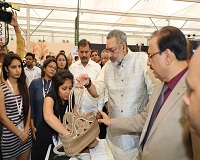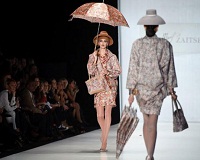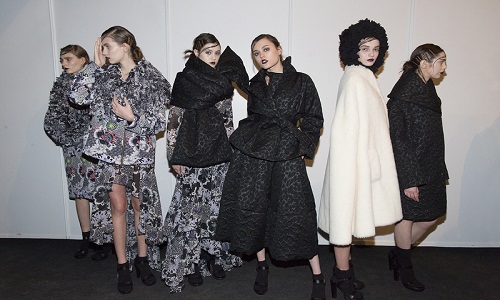FW
"Giriraj Singh, Hon’ble Union Minister of State for MSME [I/C] presented the guild certificates to nine framers in Picture Framing Segment today at 46thedition of IHGF-Delhi Fair Autumn being held at India Expo Centre & Mart, Greater Noida from October 14 – 18, 2018. Also present on the occasion were O.P. Prahladka, Chairman, EPCH, Jesmina Zeliang, President of the fair, Mohan Singh Bhati and Ahmed Akberali Sundrani, Vice Presidents of the fair, R.K. Passi and Sagar Mehta, Vice Chairmen, EPCH and Rakesh Kumar, Executive Director, EPCH. Santosh Ranjan Rai, Rajesh Chaudhary and Naveen Kumar also attended the fair."

Also present on the occasion were O.P. Prahladka, Chairman, EPCH, Jesmina Zeliang, President of the fair, Mohan Singh Bhati and Ahmed Akberali Sundrani, Vice Presidents of the fair, R.K. Passi and Sagar Mehta, Vice Chairmen, EPCH and Rakesh Kumar, Executive Director, EPCH. Santosh Ranjan Rai, Rajesh Chaudhary and Naveen Kumar also attended the fair.
Handicrafts-the backbone of Indian economy
Distributing the guild certificates to the winners, Singh stated that the Indian soul resides in the handicrafts
Paying the artisans the real value of their skills
MSME Minister further said that handicrafts sector can flourish only when these artisans are paid the real value for their skills. Whatever progress the handicraft sector has so far made, is because of hard work of the artisans and craftpersons of India.
GCF training programme to improve skills and workmanship
EPCH in collaboration with Manish Gourisaria, Joint Managing Director of M/s Lion India has taken unique initiative to upgrade the Picture Framing Industry in India by conducting GCF training programme for the Indian framers in association of Fine Art Trade Guild, London, UK. Rakesh Kumar, ED, EPCH revealed that this will enable the framers to acquire higher skills and quality of workmanship and accommodate different levels of framing with the bespoke market to International standards.
The training programme was held from March 12-17, 2018 in Kolkata. The world renowned master trainer, Stephen Finney GCF (APF) Adv. from Germany & U.K. conducted this course. It was attended by18 participants from all over India & abroad. Out of these participants who appeared for the exam, 9 passed the Guild Certified Framers examination successfully. They included Vivek Dhar from Meghalaya, J. Anto Amalraj, Tamilnadu, Chandrashekar, Karnataka, Krishnamoorthy Manivannan, Karnataka, Awani Saraogi, Telangana, S.K.R Ramesh, Tamilnadu, Nihal Sayed, Goa, Mr. Shailesh Udupi, Karnatkaka and Richie Robert from UAE.
"The October edition of Mercedes-Benz Fashion Week kicked off with traditional finale of the Futurum Moscow providing a fresh start to the event. The show kick started with futuristic and retrofuturistic collection of young designer Sakina K that comprised quilted white overcoats with Japanese hirogana symbols, black balaclavas, Yakuza-like tattoos, see-through bags and long black belts. The program Vasilisa Vetrova created by the biggest social network in the country, VKontakte, in a partnership with Futurum Moscow presented a collection inspired by the French impressionism."
 The October edition of Mercedes-Benz Fashion Week kicked off with traditional finale of the Futurum Moscow providing a fresh start to the event. The show kick started with futuristic and retrofuturistic collection of young designer Sakina K that comprised quilted white overcoats with Japanese hirogana symbols, black balaclavas, Yakuza-like tattoos, see-through bags and long black belts. The program Vasilisa Vetrova created by the biggest social network in the country, VKontakte, in a partnership with Futurum Moscow presented a collection inspired by the French impressionism.
The October edition of Mercedes-Benz Fashion Week kicked off with traditional finale of the Futurum Moscow providing a fresh start to the event. The show kick started with futuristic and retrofuturistic collection of young designer Sakina K that comprised quilted white overcoats with Japanese hirogana symbols, black balaclavas, Yakuza-like tattoos, see-through bags and long black belts. The program Vasilisa Vetrova created by the biggest social network in the country, VKontakte, in a partnership with Futurum Moscow presented a collection inspired by the French impressionism.
Streetwear in bright colors
The light and airy collection SETI combined blue, purple and teal abstract prints and opplique work in intricately-constructed dresses and shirts tied with long belts. The Daria Lukash collection, on the other hand, refurbished old carpets and wool blankets into scarves, sweatshirts and even handbags. Daniil Kostyshin’s collection combined bright-orange elements with teal, orange and blue outerwear. Vassili Volchok displayed minimalist streetwear in a striking red and black color. The Hovanskie brothers combined classic streetwear tropes with beautiful, flowing semi-transparent dresses. Otocyon showed subdued tones of black white and red, used in jackets with tasteful silver accessories, long black dresses with bright white accents, flowing skirts with thin striping and pastel coats combined with elegant felt slippers.
intricately-constructed dresses and shirts tied with long belts. The Daria Lukash collection, on the other hand, refurbished old carpets and wool blankets into scarves, sweatshirts and even handbags. Daniil Kostyshin’s collection combined bright-orange elements with teal, orange and blue outerwear. Vassili Volchok displayed minimalist streetwear in a striking red and black color. The Hovanskie brothers combined classic streetwear tropes with beautiful, flowing semi-transparent dresses. Otocyon showed subdued tones of black white and red, used in jackets with tasteful silver accessories, long black dresses with bright white accents, flowing skirts with thin striping and pastel coats combined with elegant felt slippers.
Adding a military touch to these collections
While Alkhanashvili displayed militarism with a genderqueer side, Dinara Murasova collection added a definite Asiatic flare featuring female models dressed in traditionally male military coats of olive and black. Maria Iliynishna’s collection combined small grey jackets with metal slave collar rings.
The FactiveFace collection comprised silken free-flowing garments using clashing colors and Matisse and Chagall-inspired prints in bright yellow and blue to Jackson Pollock-like splatters of black on white. Be.Li.Ve, collection ethnic prints - ranging from Maori to Aztec to Slavic - played a central role.
Inspired by global warming and eco-energy
A fully recovered fabric collection inspired by global warming and eco recovery, kruzhok showcased gas masks and breathing tubes as accessories. Another collection of practical techwear - six one six - comprised belts and buckles, Japan-inspired jackets - mostly teal and black-and-white. The Not Today collection featured long hoodies and reversible overcoats with bright red print over a white background. A collection Svarka fully inspired by the 1980’s – comprised long Matrix-inspired coats, black, red and blue color combos, and cords coming out of sleeves and collars.
Odor, a new collection from designer Nikita Kalmykov, had an assortment of light, simple sleepwear for men with long sleeves lavish silks and lace. The collection Citizen_A featured models coming out with typical housewife tools - from washing up liquid to rubber gloves and sponges. The collection itself had a constructivist feel, with plastic overcoats using mostly primary colors and transparent plastic raincoats galore.
The evening closed with a showcase of latest collection by Jean Rudoff that displayed prints ranging from Gaspar Noe-inspired neon typefaces, to classic acid symbolism of the 1990’s, with models proudly handing out fake LSD stamps with the slogan “Acid Moscow” and a smiley face.
The title partner of the Fashion Week was Mercedes-Benz. The Russian partners for the event included Schaffhausen and glo as official partners, L’Oréal Professionnel as the official stylist, Mary Kay as the official make-up artist, Harmaan as the Official partner, DHL as the Official logistics partner and Metropol as the Official hotel.
"Nearly 25 per cent of buyers who attended Leatherworld Paris this year were looking for an alternative to leather. The exhibition, held from September 17-20, 2018 in Le Bourget, Paris organized by Messe Frankfurt France, laid the groundwork for a new concept for a show dedicated to leather and related materials. This year, 44 exhibitors from six different countries attended the exhibition."
 Nearly 25 per cent of buyers who attended Leatherworld Paris this year were looking for an alternative to leather. The exhibition, held from September 17-20, 2018 in Le Bourget, Paris organized by Messe Frankfurt France, laid the groundwork for a new concept for a show dedicated to leather and related materials. This year, 44 exhibitors from six different countries attended the exhibition.
Nearly 25 per cent of buyers who attended Leatherworld Paris this year were looking for an alternative to leather. The exhibition, held from September 17-20, 2018 in Le Bourget, Paris organized by Messe Frankfurt France, laid the groundwork for a new concept for a show dedicated to leather and related materials. This year, 44 exhibitors from six different countries attended the exhibition.
This Leatherworld show was stimulated by the attendance of a dozen South African exhibitors, clothing manufacturers and designers of bags and shoes. The guest of honor was first Coco dâ™Afrique, label for leather bags was able to demonstrate that South Africa can play a role on international markets. Chimpel, a brand for leather bags and belts, surprised and delighted visitors by displaying products offered by South Africa.
Leather on display
Ningxia Shansan Industry and Trade presented a fine collection of sheepskin, cowhide and fox fur at Leatherworld Paris. Material derived from animals, offered by South Africa, Bangladesh, China, Pakistan and Turkey, were displayed. Materials intended for the same use proved to be one of the show’s attractions, thanks to greater scope for expressing creativity, both in terms of visual and tactile appeal. PU Dongguan Zhigao Leather attracted many Italian and American customers, while the polyester with an extremely soft handle, from Changshu Asia Textile Decoration was the firm favorite among designers and creative fashion labels. Ecopel, the manufacturer of fake fur, whose collections are designed in Paris, consolidated its customer base by building up a new portfolio of buyers.
Leatherworld Paris. Material derived from animals, offered by South Africa, Bangladesh, China, Pakistan and Turkey, were displayed. Materials intended for the same use proved to be one of the show’s attractions, thanks to greater scope for expressing creativity, both in terms of visual and tactile appeal. PU Dongguan Zhigao Leather attracted many Italian and American customers, while the polyester with an extremely soft handle, from Changshu Asia Textile Decoration was the firm favorite among designers and creative fashion labels. Ecopel, the manufacturer of fake fur, whose collections are designed in Paris, consolidated its customer base by building up a new portfolio of buyers.
Sustainability in focus
The trends forum showcased interesting materials along with FashionSustain stand, which demonstrated the issues of sustainable development in the shoe industry by way of some model products. A series of four lectures
(Sustainable development and marketing; all about shoes; alternatives to leather; the future of shoes by way of leather and recycling) organised on September 17 by FashionSustain examined these goals in detail, promising potential for a better future.
Creations from across the world
A Leatherworld catwalk show showcased shoes and bags from South Africa and the Turkish firm Acar Basim ve Cilt Sanayi, in addition to clothing collections and fashion accessories from Muhammad Ashraf, a Karachi tanner. Another catwalk show on 20 September dedicated to South Africa presented work by Tara Simeon, a young designer who came to people’s attention during Africa Source, another Messe Frankfurt trade fair.
To make coastal shipping more effective for bilateral trade, India has urged Bangladesh to use Kolkata and Haldia ports for transhipment purposes. This initiative can shift cargo from the costly land route, and create an opportunity for Bangladeshi garment exporters to reach European and American markets avoiding congestion at the Chittagong port.
Indian customs authorities have already cleared the deck for Bangladesh to use Haldia as a transhipment port. However, Bangladesh is yet to approve the same. The proposal was reiterated at a ministerial meeting in Dhaka recently. At the crux of the proposal is the growing need to augment handling capacities on either side, keeping in tune with growing trade volumes.
India-Bangladesh trade grew 38 per cent to $9.1 billion over the last four years. On a year-on-year basis, the trade grew 24 per cent in 2017-18. This was followed by nearly 22 per cent growth in April-July 2018.
Home textile manufacturer Welspun India has collaborated with UN Women, a subsidiary of the United Nations to help women at all levels of the value chain access skill-building initiatives in technical and entrepreneurial sectors. The company aims to create sustainable livelihoods to establish gender equality in the workforce, drive equal payment opportunities, encourage women to take up leadership roles and create a zero-harassment work environment.
This strategic partnership will strengthen the capabilities of 500 women entrepreneurs and embed them within organised value chains ensuring enterprise development, supply chain and marketing practices that will empower women. Establishing joint advocacy platforms with UN Women will promote greater representation of women in leadership across corporate India.
Welspun India is part of the $2.3 billion Welspun Group, which currently has 23 per cent women workforce and targets taking it up to 30 per cent by 2020. Recently, the company launched Welspun 2, a cut and sew unit that is entirely run by women employees.
The Turkey-Africa Economic and Business Forum held from October 10-11 had the theme ‘Invest in a Sustainable Future Together: Turkey and Africa’. The forum included a series of sideline meetings between a Ghanaian delegation and Turkish investors.
In the forum, a few Turkish textile-garment manufacturing companies expressed their desire to expand their presence in Ghana. A deal for a Turkish company to establish a ‘One-District-One Factory’ project in the Shai Hills area was also finalised. According to reports, the Ghanaian trade and industry ministry, under its industrial transformation plan, selected garment and textiles as one of the strategic sectors to generate employment and foreign exchange.
The Synthetic & Rayon Textiles Export Promotion Council (SRTEPC) has requested the Union ministery of commerce and industry to consider 6 per cent Rebate of State Levies (RoSL) rate yarns and fabrics exports. The council has also urged the ministry to include yarns and fabrics segment under RoSL scheme. The state taxes and duties are neither included in the ambit of GST nor rebated.
On priority basis, the government should consider various issues including refund of Input tax credit availed on input services, inclusion of MMF textile products falling under equal or lower rate of GST, refund of IGST on capital goods, removal of double taxation on ocean freight, immediate refund of accumulated Input Tax credit and inclusion of MMF textile products falling under equal or lower rate of GST. Also, exclude import of capital goods from GST as it is adversely affecting investment in the textile sector and defeating the purpose of the 'Make in India' initiative of the government.
South Asia Textiles, a leading Sri Lankan textile manufacturer specialised in producing exceptional quality weft knitted fabric for leading global brands like Victoria Secret, Next, Marks & Spencer, Tesco, Calvin Klein, Decathlon, Hugo Boss and Adidas, has won the Silver Award, in the “Suppliers and Service Providers to Exporters Extra Large” category, at the recently concluded NCE Export awards 2018.
In its 26th year, the NCE Export Awards recognises and rewards exemplary Sri Lankan exporters. Organised by the National Chamber of Exporters (NCE), the 2018 awards witnessed the highest number of applicants vying for these highly sought-after accolades. Additionally, participants in 2018 were judged on general export criteria including export performance, market/product development, value addition, financial performance, effective management efforts, sustainability, significant achievements related to the company and country, implementation of quality management/environment protection systems, efficient energy and waste management, branding and innovation in addition to contemporary requirements to compete in the global arena, government economic and export policies.
South Asia Textiles, a subsidiary of Ambeon Holdings, commenced its commercial operations in 2004. The company maintains its manufacturing dominance through ultra-modern manufacturing plant that produces exceptional quality weft knitted fabric. The company also specialises in knitting, dyeing, finishing, printing, brushing, sueding and preshrunk fabric.
Sri Lanka’s apparel exports grew 7.8 per cent till August 2018, compared to last year. Exports to the EU fell 7.8 per cent in August 2018 due to Brexit which is disturbing the market.
Britain is the biggest market for Sri Lankan apparel within the EU. The UK took in 40.9 per cent of Sri Lankan apparel exports to Europe in 2017. Shipments to the US grew 21.5 per cent. Sri Lanka is a big supplier to US-based Victoria’s Secret. This brand has been hit by competition in the recent past. Fluctuating Victoria’s Secret sales over the past two years has trickled down to Sri Lanka’s apparel exports to the US. But Sri Lankan apparel manufacturers have coped by increasing sales to other brands such as Calvin Klein, which are capitalising on new consumer trends to compete with Victoria’s Secret’s traditional products.
The country’s apparel exports to other markets were up 20.8 per cent from a year earlier. Exports for the first eight months of 2018 were up 4.5 per cent from 2017. Exports to the US were up 4.4 per cent from a year earlier and shipments to the EU were up 5.1 per cent.
New research by McKinsey suggests near-shoring of apparel production will soar as automation and rising labor costs in Asia add up to production costs of apparels. McKinsey surveyed industry executives and sourcing teams at leading international apparel brands. Nearly 79 per cent said near-shoring is likely to be a key purchasing factor for mass-market apparel consumers by 2025.
The report suggests sustainability is a key factor in executive decision making on this issue. Consumers are becoming increasingly aware of the environmental impact of the traditional linear apparel production modes, and the public outcry concerning overstock liquidation is becoming louder. The report also points out that while brands shifted production to Asia en masse two decades ago, the benefits of producing far away are becoming outweighed by the costs. Moreover, more nimble operators such as Boohoo – which produces much of its product in the UK – are grabbing market share.












